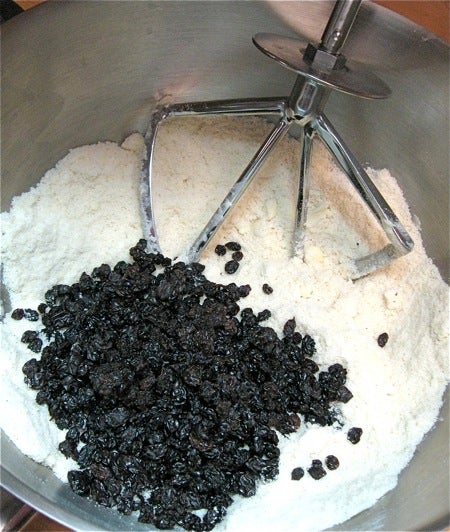


Are you Cymry?
Then you know what the words above mean.
For those who don't read or speak the Welsh language, here's the translation:
Happy St. David's Day! Enjoy Welsh Cakes.
Native to Wales, as their name suggests, Welsh Cakes are the perfect breakfast on the feast day of their native country's patron saint, St. David — celebrated each year on March 1.
These soft, tender cakes are a cross between a pancake and a baking powder biscuit, with a touch of cookie and muffin thrown in for good measure. Our version is slightly sweeter than the original, but in all other respects a fairly close match.
Sturdy enough to be eaten out of hand, they can be served plain; sprinkled with sugar (or cinnamon-sugar, our favorite); or spread with butter, and gilded with sugar or jam.
In addition, they're excellent the next day, warmed in the toaster as you'd warm toaster cakes.
Or not. Frankly, these little cakes are so melt-in-your-mouth tender, they don't even need to be re-warmed.
Intrigued? Let's make Welsh Cakes.

Place the following in a mixing bowl:
3 cups (361g) King Arthur Unbleached All-Purpose Flour
1 cup (198g) granulated sugar
2 teaspoons baking powder
1/4 to 3/4 teaspoon salt (depending on what type of butter you use; see below)
1/2 teaspoon ground nutmeg
Whisk until well combined.

Cut 16 tablespoons (227g) cold butter into pats or cubes; don't fuss over this, just chop it up.
If you use salted butter, use 1/4 teaspoon salt in the recipe. If unsalted butter is your choice, use 3/4 teaspoon salt.

Add the butter to the dry ingredients.

Work it in until the mixture is fairly evenly crumbly; a few larger pieces of butter can remain.

Next, we're going to add 3/4 to 1 cup (113g to 152g) currants.
These tiny dried grapes (pictured at right, above, next to golden raisins, for scale) will disperse nicely throughout your cakes. If you want to substitute raisins, it's best to chop them up before use.

Add the currants to the dry ingredients, and stir to combine.

Put 2 large eggs in a measuring cup. Add enough milk to measure 3/4 cup liquid total.

Whisk to combine. You should have 3/4 cup liquid.

Add the milk/egg mixture to the dry ingredients.

Mix until well combined.

Scrape the sticky dough off the sides and bottom of the bowl, divide it in half...

...and plop the halves onto a very well-floured work surface.
A word to the wise – imagine how easy it'll be to clean up if you use a silicone mat...

Shape each piece of dough into a thick, 4” to 5” disc.

Wrap one piece in plastic, and refrigerate it while you're working with the other piece.

Roll the soft dough into a 9 1/2” circle; it should be about 1/4” thick.
Be sure to lift up the dough and flour underneath it as you roll, so it doesn't stick. A giant spatula works well here.

Using a 2 1/2" to 3 1/2" biscuit cutter or other round cutter, cut the dough into circles. If you're cutting on silicone, BE GENTLE; pressing down too hard may score the silicone.
Gather and re-roll the scraps, cutting until you've used all the dough.
Heat an ungreased skillet over low-medium heat; an electric frying pan or skillet, set at 325°F, works well.

Here are your cakes, ready to fry.

It's best to fry one test cake first, to see if your pan is the right temperature.
Fry the cake for about 2 1/2 minutes on the first side...

...then about 2 1/2 minutes on the second side, until it's golden brown and cooked through.

Pull the cake apart; it should separate easily, and shouldn't look wet inside. Moist is fine; gummy isn't.
Adjust the temperature of the pan or grill if necessary to cook the cake all the way through.
Onward!

Place the remainder of the cakes on your griddle; or fry however many you can at a time.

An electric griddle is super-handy – not only can you adjust its temperature easily, you can fry a dozen cakes at once!

Transfer the cakes to a rack to cool.
Cut and fry the remaining cakes; since the dough's been refrigerated, let the cut cakes warm for about 10 minutes at room temperature before frying.
If you want to serve all the cakes warm, stow the first batch in a 200°F oven while you fry the second batch.

To serve, dust with cinnamon-sugar or superfine sugar.

A tea strainer does a nice job.

Split the cakes if you like, and spread with butter and/or jam. A pot of tea is the perfect accompaniment.
Read, rate, and review (please) our recipe for Welsh Cakes.

